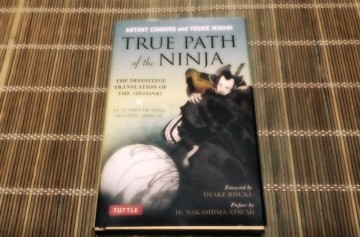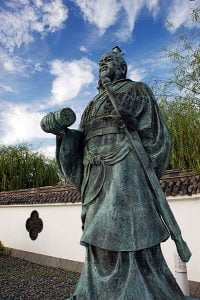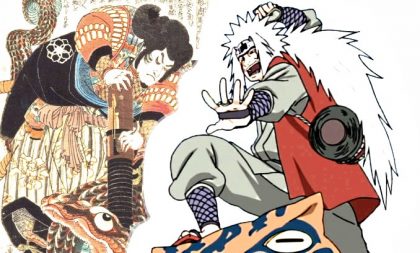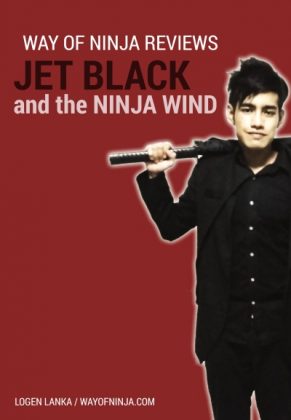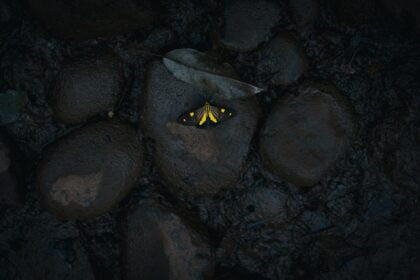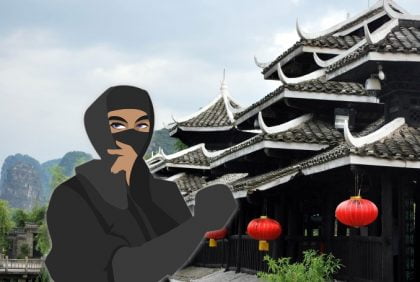Well aware that the Shoninki was one of the three ‘ancient’ authentic manuals about the ninja of historical Japan, I was eager to read True Path of The Ninja: The Definitive Translation Of The Shoninki. Yet, I faced an initial dilemma with how I ought to approach the review.
Dilemma on approaching the review for ‘True Path Of The Ninja’

The original Shoninki was written by Natori Masatake in the 17th century, who paradoxically was a samurai and ninja; he was also the grandmaster of Kishu-Ryu Ninjutsu, a Ninjutsu school that existed back in the Edo period. On the other hand, True Path of The Ninja: The Definitive Translation Of The Shoninki is a translation of the original Shoninki. This begs the question as to whose work am I actually reviewing – Anthony Cummins and Yoshie Minami (the author and translator) or Natori Masatake (the long-dead ninja and samurai who wrote the manual in old Japanese)?
Upon reading the introductory chapters that were meant to prepare the reader to understand the Shoninki, my dilemma over whose work I was reviewing evaporated. Since the original Shoninki was written in the Edo period, the nuances in the Japanese language and cultural context differ vastly from that of modern Japan. It follows then that a mere translation of the Shoninki (without interpreting and taking into account the historical, cultural and language context) would be utterly useless for the average modern reader. It would be akin to a non-English speaker attempting to read literature that is far more obscure than Shakespeare for his/her first English lesson.
Hence, as much as the concepts of the Shoninki belong to Natori Masatake and all the ninjas before him, the translators’ interpretations and contextual knowledge are important in guiding the reader into the world of the ninja. This review looks at as much of Natori’s work as the unique interpretation and inferences made by Anthony Cummins and Yoshie Minami.
Note: This review does not determine the accuracy of the translation or interpretations. To check for accuracy, I would have to either cross-check against a copy of the actual Shoninki or cross-reference several Shoninki translations from other authors; this is my only copy of a translated Shoninki and I can’t interpret ‘old’ Japanese. But I may update this review in the future when I get my hands on other Shoninki translations.
Structure of ‘True Path Of The Ninja: The Definitive Translation Of The Shoninki’
The True Path Of The Ninja: The Definitive Translation Of The Shoninki is structured in the manner as follows. And to clarify, the Shoninki focuses on the espionage techniques and strategies of Kishu-Ryu, not the martial arts.
- Introduction
- The Preface to the Shoninki
- The Shoninki Opening Chapters
- The Shoninki Middle Chapters
- The Shoninki Final Chapters
Introduction
As mentioned, Anthony Cummins and Yoshie Minami prepare the modern reader for their journey into historical Japan and the ninjas’ world within the introduction sections. Here, you will learn about Natori Masatake, the Kishu-Ryu Ninjutsu School and how the Shoninki is applicable to Ninjutsu practitioners, enthusiasts and martial artists alike.
In addition, the introduction devotes a few pages to the challenges of translating the Shoninki, which enables the reader to appreciate the importance of historical and cultural context. Since society, language and culture evolve over time, it would be ludicrous to judge and interpret translations set in Edo Japan based on modern-day values, ethics and mindset. Understanding this allows you to truly immerse into the ninja world, and see through the eyes of Natori with awareness of the cultural norms unique to his time.
The Preface to the Shoninki & The Shoninki Opening Chapters
The Shoninki (considering it was a manual of a Ninjutsu school) was surprisingly prefaced by a samurai from Natori’s clan, who wrote about the ninja respectably. Keeping in mind that Natori was both samurai and ninja, it still left a question as to why a samurai would speak favourably about a ninja’s tactics when it runs contrary to their code. It turns out that the assumption that samurai and ninja were at the opposite spectrum and mortal enemies was inaccurate. Herein is the rare opportunity to explore the perceptions and relationship between ninja and samurai.
The Shoninki (Translated)
new edition
The original Shoninki was written by Natori Masatake in the 17th century; he was also the grandmaster of Kishu-Ryu Ninjutsu, a Ninjutsu school in the Edo period.
Disclosure: The “True Path Of The Ninja: The Definitive Translation Of The Shoninki” was given to me by Tuttle Publishing in return for an honest review. I have not and will not give dishonest reviews for monetary or other benefits.
Also, within part one, Natori establishes what a ninja is and the types of shinobi that exists. He goes further to distinguish ninja from nusubito (thieves), with -it seems to me- a hint of contempt for having the ninja being confused as nusubito. As a side note, it was obvious from the opening chapters that Sun Tzu’s Art of War, the oldest military treatise from China, had influence on ninja philosophy; particularly when Natori identifies the five types of spies.
Where the preface and part one focuses on laying the groundwork and definitions of ninja, the opening provides information on the foundational espionage techniques, outlining basic tools, weapons, infiltration and teamwork.
The Shoninki Middle Chapters
In the Shoninki Middle Chapters, Natori goes into detail as to specific techniques on evading capture, infiltration, and manipulating and hiding within an unfamiliar environment. Also, in this section are physiognomy, ninja magic and divination.

While I found physiognomy an art as “believable” as our modern-day horoscopes, I had fun reading this section and couldn’t help but use a toothpick to lazily count the number of teeth I had, so as to determine my fortune. Alas’, I have base luck and am a mean person. I wasn’t too keen in analysing the rest of my attributes after that… Anyway, Natori has acknowledged that physiognomy was inaccurate and ninja should not risk being discourteous by staring at a person’s face for too long.
In reading between the lines for the chapter on ninja magic, I believe that the magic behind kuji-in and other spells works as a means to affect the ninja’s psyche and mindset. Similar to meditation and prayer, when you truly believe something will happen, your behaviour and action subtly changes to make things happen. And in an old article, I’ve mentioned that kuji-in was simply a means to access a specific state of mind swiftly.
The Shoninki Final Chapters
The final chapters of the Shoninki gets philosophical and covers the ninja’s understanding of psychology during their time. And let me assure you that the ninja’s understanding and application of psychology was impressive (even if you were to use that knowledge in the modern context).
My thoughts on Natori’s Shoninki
As much as I expected the Shoninki to be a clear how-to guide on ninjutsu espionage techniques and strategies, there were some deficiencies in clear instructional details attributing to two reasons: (1) Ninjutsu is an art passed down orally through teacher to student, and (2) some techniques were used to identify if a ninja was from the same clan; putting it within the Shoninki would be risky if the document was ever stolen.
However, while you shouldn’t expect a step-by-step instruction manual on constructing a ninja torch from the Shoninki, I found many espionage techniques, strategies and knowledge still relevant in our modern world. Even if you aren’t working as a modern-day spy, the espionage techniques and ninja philosophy can be tweaked for use in your daily lives (especially as martial artists and ninja enthusiasts). I will go into examples in the last section on my final thoughts about the book.
For now, the below are some examples of what I learnt about the ninja that surprised me.
Samurai respected the ninja and did employ them for work that goes against their code
As briefly mentioned earlier, I was surprised about the preface being written by a samurai, which hinted at the respectful perceptions samurai had of ninja. Reading further into the Shoninki, aided by Cummins’s and Minami’s notes, it was clear that the samurai had respect for the ninja and their methods of deception, even though the concept of espionage contradicted the Samurai’s code; the samurai believed that the ninja’s role was a necessity to safeguard the lords they served.
Furthermore, what I found interesting was the idea that deception (in historical Japan) could be seen as courageous or cowardly depending on the situation. And it is based on my surmise that the samurai did distinguish deception against evil and deception against the innocents; the ninja were associated with the former. Shinobi were respected for their discipline to employ espionage techniques honourably, unlike nusubito and other criminals.
Ninja knowledge was based on shockingly detailed observations, experience through application and sophisticated deductions from several bodies of knowledge
What shocked me when reading the Shoninki was how intuitive the espionage techniques were, and yet without knowing the bodies of knowledge from which they were derived, a normal person is unlikely to know how the ninja operated. I would liken reading the Shoninki to learning the secrets of the modern magician; it is amazing how one can combine a few simple concepts to build a complex theory, especially in the historical age of the ninja.
Some bodies of knowledge gleaned from detailed observation were navigation techniques (in a pre-Google maps world), human psychology, street knowledge of where and how to gather information, how to steer conversations based on context and body language of the target, and how to infiltrate enemy residences in plain sight (without them even knowing what’s happening). I could only imagine how much observation, experience and deductive reasoning it took to accumulate such intuitive techniques.
Skill in conversation, psychology and emotional intelligence were more useful than skills in combat
This brings me to the next point, conversational skills, emotional intelligence and an intuitive understanding of psychology was more important to a ninja than combat skills itself. The purpose of a ninja is to gather intelligence; fighting almost guarantees that the ninja has failed. The many techniques within the Shoninki used to gain trust of the enemy was a testament to the ninja’s understanding of human psychology; it made sense to read.
The Importance of Anthony Cummins’s & Yoshie Minami’s Interpretations
Before every chapter in the Shoninki, Cummins and Minami added introductory texts that provided context to what Natori was saying and informs the reader of what concepts to look out for. There have been some chapters where I found the concepts of the Shoninki quite abstract and unclear. Their notes have been immensely helpful, even if they did have to infer and deduce Natori’s meaning from historical context.
Since the translators notes and summaries were marked in italics, it was easy to differentiate the words of Natori and the modern interpretation; a point of differentiation is important to ensure the translator’s interpretations are not melded with the original author. It leaves room for those who prefer to cross-reference and read ‘between the lines’ to do so.
Another thing I liked about the author and translator was their efforts to verify the plausibility of certain Shoninki techniques with the modern-day headmaster of Tenshinsho-den Katori Shinto-Ryu, one of the oldest schools in Japan still in existence that still taught Ninjutsu as a sub-art. The translators’ healthy scepticism on certain far-fetched techniques and corresponding verification, makes for a better reading for us ninja enthusiasts.
Minor Criticisms
Overall, I’m happy with the reading experience I had for True Path Of The Ninja: The Definitive Translation Of The Shoninki. Yet, there are a few notes by the translator that I feel can be much better explained. I acknowledge that with any translation work that needs significant contextual inferences, such as the Shoninki, there are many ways the text can be interpreted.
Here is one of the introductory texts that I initially found confusing and poorly explained.
In the chapter on Defending Yourself Against the Enemy, spanning less than a page, Natori mentioned nothing about homosexuality. However, the introductory text talked about homosexuality in warrior culture, which left me scratching my head as to the relation between Natori’s words and what the translators have explained.
It was only through inference that I found the two sentences by Natori that could be interpreted as unusual if you had some knowledge on Japanese history and culture; Natori made a statement that a ninja can lure their target with alcohol, sex, pleasure and gambling, and further talked about being included in that ‘pleasure’.
Historically and culturally, Japan was male-dominated and was accepting of homosexuality, namely within samurai culture. As such, when Natori spoke of luring the target with sex, there is an implicit understanding that sexual activity can include sex with the same gender since the ninja and his target are statistically more likely to be both male. When you add these two together, you can reasonably assume that Natori includes same-gender sexual activity as part of luring, even if Natori has not explicitly mentioned it.
Unfortunately, the translators did not explain the ‘jump’ in inference, which may cause confusion to some readers. However, (this is a crucial acknowledgement) even Cummins and Minami acknowledge that Natori could have also possibly meant ‘supplying prostitution’ as a ninja to lure the target, with no allusion to homosexuality.
Final Thoughts On The Book
There is much you can learn about the shinobi and Edo Japan from this book: True Path Of The Ninja: The Definitive Translation Of The Shoninki. The ninja’s philosophy, strategies and techniques are definitely still applicable to the modern age (with a little tweaking).
The Appeal To Ninja Enthusiasts and Martial Artists
Just like other ninja enthusiasts, the prospect of reviving the way of ninja sounds appealing to me. Yet, the modern revivals of the ninja way have almost always been represented in form rather than essence; we are obsessed with replicating the look and history of the ninja but not the essence. Techniques are merely techniques. Costumes are just costumes. Techniques and clothes change over time. Do not mistake the form for the essence of ninja. It is the mindset and essence of what a ninja is that is important to replicate.
This book presents the fundamental ideals of the ninja and reveals the core or essence of the ninja implicitly.
- ability to adapt to circumstances and blend with the surroundings
- discipline to tame their ego for the sake of furthering their mission
- ability to exercise reason, judgement and patience
- ability to let go when the best efforts have been exhausted under the prevailing circumstances.
By studying the Shoninki, we can apply the fundamental mindset of the ninja and navigate through life with discipline towards our goals, adapting and blending with situations as they arise, doing our best, so that at the end we can become detached from the outcome. This is at least how I see its relevance to the modern world.
Getting As Much Out of The Book
To truly be able to get something out of the True Path Of The Ninja: The Definitive Translation Of The Shoninki, you need to read it critically with a dose of healthy scepticism. The ninja of old would have done the same and are taught to read between the lines. Not everything is going to be clear, and there may sometimes be more questions than answers. While Cummins and Minami are there to guide you in interpreting what Natori is hinting subtly at, there are a few occasions where Natori isn’t clear.
Verdict: “True Path Of The Ninja: The Definitive Translation Of The Shoninki” Recommended
I would definitely recommend this book to ninja enthusiasts, Japanese history buffs, body language enthusiasts and martial artists. The list price of the book of $12+ is highly affordable and priced lower than other Shoninki translations. And it would be good for any ninja enthusiast to own a translated copy of one of the three major ninja manuals.
Please share your thoughts about the book and the review! Special thanks to Tuttle Publishing.
The Shoninki (Translated)
new edition
The original Shoninki was written by Natori Masatake in the 17th century; he was also the grandmaster of Kishu-Ryu Ninjutsu, a Ninjutsu school that existed back in the Edo period.
This English translation is the work of Antony Cummins and Yoshie Minami – known as True Path of the Ninja.
Disclosure: The “True Path Of The Ninja: The Definitive Translation Of The Shoninki” was given to me by Tuttle Publishing in return for an honest review. I have not and will not give dishonest reviews for monetary or other benefits.

